Leeds School Board Industrial School for Girls, Thorparch, West Riding of Yorkshire
The Leeds School Board's Industrial School for Girls on Walton Road, Thorparch (or Thorp Arch) formally came into operation on 6th January, 1896, having received its official certification two days earlier. The new premises replaced the Board's existing girls' Industrial School, Windsor House, located on Windsor Street in the Burmantofts area of Leeds.
The Thorparch site had previously been a boys school, opened on 5th August 1855, by Mr Hiley with 41 pupils. The buildings had an L-shaped layout and Mr Hiley hoped that if the school were successful, he would be able to complete the quadrangle. Unfortunately, his health failed and his son, the Rev. Richard Hiley, took over the school in 1861. The school was forced to close during a scarlet fever epidemic in 1869, then in 1887 the site was sold to the Leeds School Board. Conversion of the premises for use a girls' industrial school was supervised by the School Board's architect, Mr W.S. Braithwaite of Leeds.
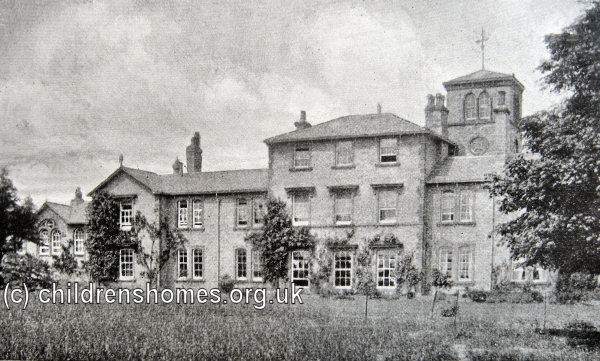
Thorparch Girls' Industrial School from the south, c.1900. © Peter Higginbotham
The school could accommodate up to 100 girls, aged from 7 to 15, placed there by magistrates for a period of up to five years for reasons such as:
- their parents could not control them
- they had been found begging, wandering and homeless
- they were living in a brothel, or associating with prostitutes
The School's official opening ceremony on 23rd June 1896, the event being reported in the following day's Leeds Mercury.
The Thorparch Girls' Industrial School, which has recently been acquired by the Leeds School Board, was formally opened yesterday. It is situated at Thorparch Grange, which was for some years occupied by Dr. Hiley, who conducted an academy there, and is intended for the reception and care of girls of schoo1 age who have got beyond parental control, or whose home surroundings are of such a character as to make it imperative in their own interests to remove them, and place them under proper guardianship. Thorparch Grange which is beautifully situated, lies within five minutes walk of the railway station. The spacious building, with fourteen acres of land attached, was acquired for £3,500 by the School Board, who have since spent a considerable sum in alterations and improvements, carried out under the supervision of Mr. W. S. Braithwaite, architect, of Leeds. As now arranged, the school contains on the ground floor a spacious dining hall, day-room, school and class rooms, and knitting and sewing rooms, all of them being well lighted. and ventilated. On the floor above, which is approached by a wide fireproof staircase, are three larger dormitories, besides smaller rooms, bath-rooms, and lavatories, &c., and on the third story is the infirmary, which is provided with every convenience, and can be readily isolated. There is also a detached building, which can be used as a sanatorium, though it is intended to send any infectious cases to the city hospital. The institution, which has large fruit and flower gardens, likewise possesses a gymnasium and facilities for outdoor recreation; and amongst the domestic arrangements are a laundry, with steam power, and a bakehouse, in both of which the girls will undergo training, They will also be taught the making and mending of garments. and in other ways trained for a useful home life. The Board will bring to the aid of the school its large staff of experts in cooking, singing, physical training, &c. It is not intended to keep the children until thy are sixteen years of age, if they are before that fit to be licensed out, although to insure effective control orders for detention should be for the full period prescribed by the Act. The institution is licensed for 100 children, and at present contains about half the number, including 24 handed over by the managers of the Windsor-street Industrial School. The lady superintendent and matron is Miss Levers, and she has under her an efficient staff. Already the board have accepted girls from various other towns, including Manchester and South Shields, and arrangements have been made to receive children sent by the London School Board. It is anticipated that in a short time the institution will have its full complement. The structural alterations have been carried out by Mr. W. S. Hannam. Mr. T. Storey did the plumbing, and Messrs. Dingall and Co. the iron work.
The school was opened for use on the 6th January last, but the arrangement of the establishment was not of then completed,. and the event was not marked by any ceremony. In one respect, at least, this was a fortunate circumstance, for what constituted the formal opening of the school took place in delightful summer weather yesterday, when a numerous company of ladies and gentlemen interested in education and rescue work in Leeds and other parts of the country visited the place as guests of the Rev. Egerton Leigh, Vicar of Kirkstall, Chairman of the Industrial Schools Committee, to whose initiative the school owes its existence. The company included present and former members of the Leeds School Board, the Clerk and members of the of staff of the board, Mr. A. Owen, Her Majesty's Sub-Inspector for the Leeds District, the inspectors under the Leeds Board, Mrs. Homan, Chairwoman of the Girls' Section of the Industrial Schools Committee of the London School Board, representatives of the Manchester, Salford, Bradford, and Sheffield School Boards and of the committee of the Windsor-street Industrial School, Leeds, the architect; (Mr. Braithwaite), the contractor (Mr. Hannam), and various other ladies and gentlemen. The guests travelled from Leeds to Thorparch in saloon carriages attached to the 1.35 train, and on arriving at the school were received on the lawn by the Rev. Egerton Leigh. Although the weather in the morning had been of the most unpleasant description, it was warm and bright throughout the afternoon and evening, and, as was hoped, the greater portion of the time was passed out of doors. The reception over, seasonable refreshments were served, selections of music being played the while by the band of the Shadwell Industrial School, under Bandmaster J. G. Joyce. Mr. Dimery, superintendent of that institution, was also among the guests. Half an hour having been passed in this agreeable manner, the visitors proceeded to the he schoolroom, where the children gave an exhibition of musical drill, and subsequently made an inspection of the house, the guests finding much to admire, alike in the arrangement of the institution and the appearance of health and happiness which its inmates presented. The remainder of the afternoon was spent, in strolling about the garden and grounds, and at five o'clock tea was served in the sewing-room.
At the close of the meal, Mr. Tiffany, on behalf of the architect and contractors, presented the Rev. Egerton Leigh with a handsome silver-mounted salad-bowl. The gift, he said, which took the place of the ornamental key usually presented on such occasions, would serve as a memento of the opening of an institution which was provided for the intellectual, moral, and physical advantage of those who were now and would hereafter be its inmates. Mr. Leigh was to be congratulated on the success of the undertaking. The fact was that the city of Leeds had not bought the place. They had, comparatively speaking, had it given to them, having obtained the estate of fourteen acres for what auctioneers would term the "ridiculously low prices" of £3,500. which was about £250 an acre, with that fine building attached. He did not doubt that if that place had had to be built be four or five times the price paid would not have covered he the outlay. (Hear, hear.) To a great extent that satisfactory result was due to the architect and contractors, and to the skilful generalship which the Vicar of Kirkstall had displayed in the conduct of the whole affair. (Hear, hear.) The Rev. J. Longbottom and Mr. G. J. Cockburn having also addressed the meeting, the Rev. N. Egerton Leigh returned thanks.
The company then adjourned to the lawn, where pieces were sung by the children, and later the party returned to Leeds. The children and the members of the Shadwell Industrial School Band were also provided with good things during the afternoon.
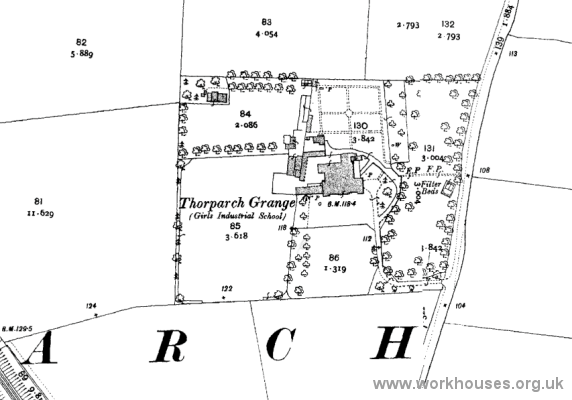
Thorparch Girls' Industrial School site, c.1909.
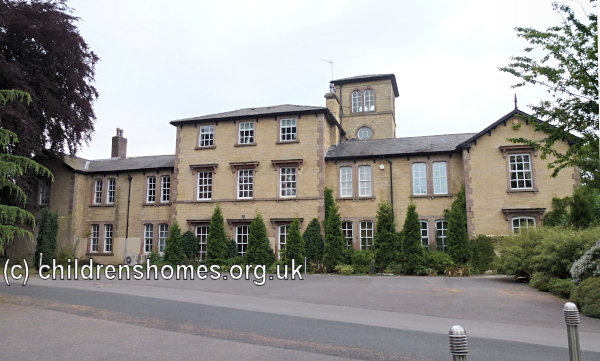
Thorparch Girls' Industrial School from the south, 2012. © Peter Higginbotham
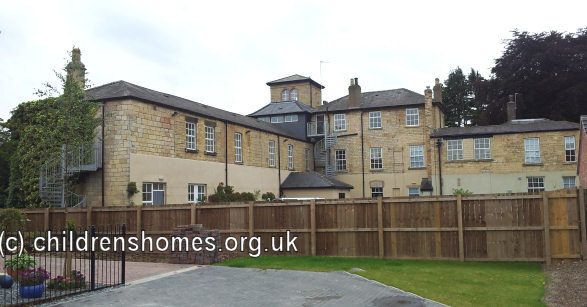
Thorparch Girls' Industrial School from the north-west, 2012. © Peter Higginbotham
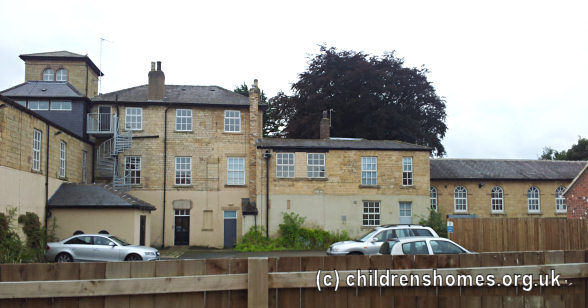
Thorparch Girls' Industrial School from the north, 2012. © Peter Higginbotham
In April, 1909, Miss C. Levers, who had superintended the School since its opening, resigned and was succeeded by Miss R.H. Phillips. Miss L. Reading was appointed as head teacher on the same date.
An inspection in 1911 recorded 100 inmates at the School, with 19 out on licence. In the classroom, singing was rated as 'very fair', composition and recitation as 'good', and mental arithmetic varying from 'fair' to 'good' in different classes. In elementary science and hygiene, a good course of lessons was being followed. Good object lessons were given in the middle and lower classes. Domestic economy, including household accounts, was carefully studied in the schoolroom, and drawing was also taught. All the girls, except the very young ones, mended all their own clothes. The senior girls cut-out all the garments they made, including a set of new dresses. Cookery was taught by a visiting teacher. Eight girls each cooked an excellent two-course dinner on the day of inspection. Practical laundry work was rated as 'good', with notes on theory being taken in the schoolroom and supplemented by lessons given by the laundry matron. Drill was given to three squads of girls by a qualified visiting instructor. The senior squad, it was said, would be difficult to beat for grace of movement. The girls had had their usual outdoor games, walks, etc. There was a mark system in operation carrying money awards for good behaviour. Another great aid to good conduct was the encouragement given by the "Endeavour Guild." Thanks to the committee ladies who take an active interest in this, the girls wore buttons, ribbons, or medals, of which they are very proud, denoting they are members of this Guild. The good-conduct girls spent a day at Scarborough in the summer. At Christmas the usual festivities took place.
In 1915, the superintendent was Mrs A.J. Smith; in 1920, Mrs K. Carney; and in 1930, Miss A. Harrison.
In the 1920s, the establishment adopted the name Thorparch Grange School.
In 1933, Thorparch Grange became an Approved School, one of the new institutions introduced by the 1933 Children and Young Persons Act to replace the existing system of Reformatories and Industrial Schools. The School initially accommodated up to 100 Junior Girls aged under 15 birthdays at their date of admission.
In March, 1935, the School was converted to instead accommodate up to 80 Junior Boys aged under 13 at their time of admission. The headmaster in 1936 was Mr H.V. Laurie. By 1965, the accommodation had been increased to 100 places. The headmaster at that date was Mr A.R. Ralph.
In 1973, the School became a Community Home with Education for young people in local authority care. After the closure of the home in the 1990s, the site was sold to a property developer. The former School building has now been converted to offices, with the west of the site used as a football training ground by Leeds United.
Records
Note: many repositories impose a closure period of up to 100 years for records identifying individuals. Before travelling a long distance, always check that the records you want to consult will be available.
- West Yorkshire Archive Service (Leeds Office), Nepshaw Lane South, Morley, Leeds LS27 7JQ. Holdings: Admissions registers (1896-1908, 1908-30); After care records (1915-25); Leeds Union of Children's Homes, register of children (1925-43); Leeds Union Central Home for Children, religious creed register (1907-27); Headmaster's diaries (1957-71); Punishment books (1931-71); 'The Grange Magazine' (1938-70); Visitors' book (1965-69); Admissions and disposals register (1944-63).
Bibliography
- Higginbotham, Peter Children's Homes: A History of Institutional Care for Britain's Young (2017, Pen & Sword)
- Mahood, Linda Policing Gender, Class and Family: Britain, 1850-1940 (1995, Univeristy of Alberta Press)
- Prahms, Wendy Newcastle Ragged and Industrial School (2006, The History Press)
Links
- None noted at present.
Except where indicated, this page () © Peter Higginbotham. Contents may not be reproduced without permission.


